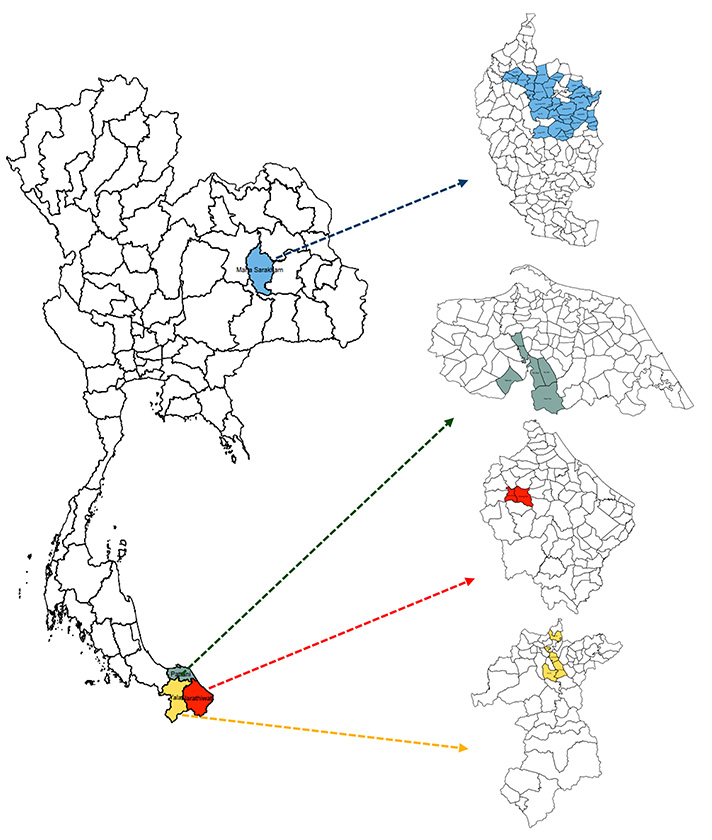Data Overview
Newborn Cohort Data (NCD) is a part of the Thailand Childhood Longitudinal Survey (TCLS), a comprehensive annual panel data from rural areas of Thailand. The survey started in June 2021, targeting newborn children in two regions of Thailand: Mahasarakham province in the northeast (a relatively poor region) and Narathiwat, Pattani, and Yala provinces in the south (with a Muslim majority).
Structure of the Questionnaire
The questionnaire (QN) comprises five main parts: household QN, pregnant-conditions QN, children information QN, child development QN, and school QN.
1. Household QN was adapted from the Annual Townsend Thai Data Survey and Thailand Socio-Economic Survey (SES), which collected detailed information about each individual in the household, e.g., jobs, education, age, gender, labor income, occupations, etc., and household information, e.g., household assets, expenditures, etc. In addition, this survey asked about time spent on working, sleeping, and other forms of leisure and the health problems of each household member. Further, we will elicit caregivers’ risk, time, and social preferences.
2. Pregnant-conditions QN asked for retrospective information from the mother and mother-child booklet (recorded by health care providers). This part interviewed mothers about depression during pregnancy and extracted information about the mother, health checkups during pregnancy, and delivery conditions from the booklet.
3. Children information QN asked for information about the child’s foods and milk, breastfeeding, child-rearing time, father involvement, information acquisition, and time adults in the household spent with the child (e.g., reading, singing, playing, holding, etc.). This part of the QN was adapted from several sources, including the Cohort Study of Thai Children, the World Health Organization Quality of Life, the National Educational Panel Study, and the Early Childhood Longitudinal Program. Like the pregnant conditions, we extracted information about the child’s vaccinations, health checkups, and delivery conditions (gestation duration, birth weight, body length at birth) from the mother-child booklet (recorded by health care providers).
4. Child development QN interviewed primary caregivers regarding Gross Motor, Fine Motor, Receptive Language, Expressive Language, and Personal and Social (based on DSPM developed by the Ministry of Public Health of Thailand). In the later year, each child is assessed regularly using standard instruments, e.g., DENVER II, Wechsler Intelligence Scale for Children (WISC), etc. Moreover, we will similarly elicit children’s risk, time, and social preferences to the caregivers.
5. School QN collected basic information from school directors and teachers. This part of the QN will start once the children are in childcare centers. This QN may include classroom observations if the budget permits.
Sampling Framework
The survey covers 38 Subdistricts or Tambons: 26 in Mahasarakham (low fertility rate region) and 12 in the south (high fertility rate region). Note that Tambon is the smallest official local governmental organization in Thailand. Each Tambon in the survey area consists of 4 to 24 villages. We began the sampling by collecting the number of newborns (still younger than one-year-old on May 16 next year, the cutoff date for school entry in Thailand) from local healthcare centers. We excluded villages with less than two newborns to optimize the logistic costs. We then randomly chose 150 villages out of 162 villages using simple randomization (100 in the northeast and 50 in the south). We set the target sample of 250 children in each region.
To determine the number of samples in each village, we asked village health volunteers who lived within the villages to conduct the census to collect data on the number of newborn children in each of those 150 villages. The sample size in each village is proportional to the number of newborn children relative to the target in each region. We then randomly chose samples within each area using simple randomization. If a sample household refused the interview or the primary caregiver was unavailable for an interview during the survey period, a replacement would be randomly chosen from the rest of the eligible children in the village. If no eligible children were left in the village, we would randomly select from the rest of the villages until we reached the target.
The Newborn cohort sample at the beginning of the 2021 survey consisted of 507 newborns (aged below one on May 16, 2022). We added two more generations of samples: newborns in 2022 and 2023. Due to the low fertility rate in the northeast, we need to add 48 more villages to reach the target of 250 children each generation. However, 382 newborns entered the survey in 2023, while 529 entered in 2023. See the sample size for each survey year in the table below. Note that the attrition rate was relatively high in the first few years.
Sample Size in Each Survey Year
|
Year |
Children |
Household |
|
2021 |
507 |
484 |
|
2022 |
959 |
920 |
|
2023 |
1,225 |
1,141 |
Map showing Survey Tambons

Funding
The survey has been continuously supported by the Equitable Education Fund (EEF).


